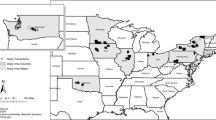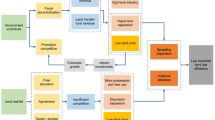Abstract
This study explores the impact of wind facilities on land values based on wind farm construction and land transaction datasets in China from 2005 to 2017. We implement a two-way fixed effects model to estimate the causal effects of the siting of wind farms on land prices. Our results show that the siting of wind farms significantly impacts land transaction prices. On average, land parcels located within 10 km of a wind farm enjoy a 4.78% price premium. However, land parcels located within 1 to 3 km of a wind farm experience depreciation, while lands located within 3 to 6 km of a wind turbine experience an increase on average. We further find that offshore wind farms are viewed more favorably by nearby residents compared to inland wind farms.






Similar content being viewed by others
Notes
Building on Past Achievements and Launching a New Journey for Global Climate Actions. Ministry of Foreign Affairs, the People's Republic of China. https://www.fmprc.gov.cn/mfa_eng/zxxx_662805/t1839779.shtml, last checked, Nov 2021.
According to the technical report of wind farm installations, the average distance between two turbines (generally 1.5 KW capacity for each) are approximately 500 m. Therefore, there are 16 turbines in each 2*2 km grid. In the wind farm dataset, each wind farm averagely has 50 turbines, occupying four 2*2 km grids. The difference in the distance from a specific land to a typical square-shaped wind farm and to a typical rectangle-shaped wind farm is 2 km. That is, the measurement error in the distance between a land parcel to the nearest wind farm boundary is 2 km.
The nighttime light data is acquired from https://ngdc.noaa.gov/eog/index.html.
LandScan data is acquired from https://www.ornl.gov/project/landscan.
The average radius of a town, the smallest administrative level in China, is 3.5 km.
We also tried wind farm by year fixed effects and different sets of county level fixed effects. Eventually, it’s excluded from the regression because the land was traded only once and normally there is only one wind farm in a county. Adding county-level fixed effects or wind farm by year fixed effects lead to lack of variations.
References
Alonso W (2014) Chapter 1: A theory of the urban land market. In: Lake RW (ed) Readings in urban analysis. Routledge, New York
Álvarez-Farizo B, Hanley N (2002) Using conjoint analysis to quantify public preferences over the environmental impacts of wind farms. an example from Spain. Energy Policy 30(2):107–116
Beery JA, Day JE (2015) Community investment in wind farms: funding structure effects in wind energy infrastructure development. Environ Sci Technol 49(5):2648–2655
Brunner E, Hoen B, Hyman J (2022) School district revenue shocks, resource allocations, and student achievement: evidence from the universe of US wind energy installations. J Public Econ 206:104586
Cai H, Wang Z, Zhang Q (2017) To build above the limit? Implementation of land use regulations in urban China. J Urban Econ 98:223–233
Carr-Harris A, Lang C (2019) Sustainability and tourism: the effect of the United States’ first offshore wind farm on the vacation rental market. Resour Energy Econ 57:51–67
Chen Y (2019) Renewable energy investment and employment in China. Int Rev Appl Econ 33(3):314–334
Cullen J (2013) Measuring the environmental benefits of wind-generated electricity. Am Econ J Econ Pol 5(4):107–133
Dammeier LC, Loriaux JM, Steinmann ZJN, Smits DA, Wijnant IL, van den Hurk B, Huijbregts MAJ (2019) Space, time, and size dependencies of greenhouse gas payback times of wind turbines in northwestern Europe. Environ Sci Technol 53(15):9289–9297
Davidson DJ (2019) Innovating for a renewable energy transition. Nat Energy 4(4):254–256
Deschênes O, Greenstone M (2007) The economic impacts of climate change: evidence from agricultural output and random fluctuations in weather. Am Econ Rev 97(1):354–385
Devine-Wright P (2005) Beyond nimbyism: towards an integrated framework for understanding public perceptions of wind energy. Wind Energy 8(2):125–139
Dröes MI, Koster HRA (2016) Renewable energy and negative externalities: the effect of wind turbines on house prices. J Urban Econ 96:121–141
Fu S, Xiaocong Xu, Zhang J (2021) Land conversion across cities in China. Reg Sci Urban Econ 87:103643
Gibbons S (2015) Gone with the wind: valuing the visual impacts of wind turbines through house prices. J Environ Econ Manag 72:177–196
Gibson J, Olivia S, Boe-Gibson G, Li C (2021) Which night lights data should we use in economics, and where? J Dev Econ 149:102602
Goulder LH (1995) Environmental taxation and the double dividend: a reader’s guide. Int Tax Public Financ 2(2):157–183
GWEC (2021) Global wind report 2021, June 03, 2021, from Global Wind Energy Council. https://gwec.net/global-wind-report-2021/
Haninger K, Ma L, Timmins C (2017) The value of brownfield remediation. J Assoc Environ Resour Econ 4(1):197–241
Heintzelman MD, Tuttle CM (2012) Values in the wind: a hedonic analysis of wind power facilities. Land Econ 88(3):571–588
Heptonstall PJ, Gross RJK (2021) A systematic review of the costs and impacts of integrating variable renewables into power grids. Nat Energy 6(1):72–83
Hoen B, Wiser R, Cappers P, Thayer M, Sethi G (2011) Wind energy facilities and residential properties: the effect of proximity and view on sales prices. J Real Estate Res 33(3):279–316
Hoen B, Brown JP, Jackson T, Thayer MA, Wiser R, Cappers P (2015) Spatial hedonic analysis of the effects of U.S. Wind energy facilities on surrounding property values. J Real Estate Finance Econ 51(1):22–51
HUAXIAWIND (2014) Report on market and existing projects of wind power in China, Xuzhou
Jansen M, Staffell I, Kitzing L, Quoilin S, Wiggelinkhuizen E, Bulder B, Riepin I, Müsgens F (2020) Offshore wind competitiveness in mature markets without subsidy. Nat Energy 5(8):614–622
Jensen CU, Panduro TE, Lundhede TH (2014) The vindication of don quixote: the impact of noise and visual pollution from wind turbines. Land Econ 90(4):668–682
Krekel C, Zerrahn A (2017) Does the presence of wind turbines have negative externalities for people in their surroundings? Evidence from well-being data. J Environ Econ Manag 82:221–238
Krueger AD, Parsons GR, Firestone J (2011) Valuing the visual disamenity of offshore wind power projects at varying distances from the shore: an application on the delaware shoreline. Land Econ 87(2):268–283
Lang C, Opaluch JJ, Sfinarolakis G (2014) The Windy City: property value impacts of wind turbines in an urban setting. Energy Econ 44:413–421
Liu Z, Guan D, Wei W, Davis SJ, Ciais P, Bai J, Peng S, Zhang Q, Hubacek K, Marland G (2015) Reduced carbon emission estimates from fossil fuel combustion and cement production in China. Nature 524(7565):335–338
Lu X, McElroy MB, Chen X, Kang C (2014) Opportunity for offshore wind to reduce future demand for coal-fired power plants in china with consequent savings in emissions of CO2. Environ Sci Technol 48(24):14764–14771
Lu X, McElroy MB, Peng W, Liu S, Nielsen CP, Wang H (2016) Challenges faced by China compared with the U.S. in developing wind power. Nat Energy 1:16061
Masson-Delmotte V, Zhai P, Pörtner HO, Roberts D, Skea J, Shukla PR, Pirani A, Moufouma-Okia W, Péan C, Pidcock R (2018) Global warming of 1.5 °C. An IPCC special report on the impacts of global warming of 1.5 °C. Intergovernmental Panel on Climate Change
Muehlenbachs L, Spiller E, Timmins C (2015) The housing market impacts of shale gas development. Am Econ Rev 105(12):3633–3659
Novan K (2015) Valuing the wind: renewable energy policies and air pollution avoided. Am Econ J Econ Pol 7(3):291–326
Onakpoya IJ, Osullivan J, Thompson MJ, Heneghan CJ (2015) The effect of wind turbine noise on sleep and quality of life: a systematic review and meta-analysis of observational studies. Environ Int 82:1–9
Read DL, Brown RF, Thorsteinsson EB, Morgan M, Price I (2013) The theory of planned behaviour as a model for predicting public opposition to wind farm developments. J Environ Psychol 36:70–76
Richardson M, Liu P, Eggleton M (2022) Valuation of wetland restoration: evidence from the housing market in Arkansas. Environ Resour Econ 81(3):649–683
Saiz A (2010) The geographic determinants of housing supply. Q J Econ 125(3):1253–1296
Shen X, Pengfei L, Yueming Q, Anand P, Parth V (2021) Estimation of change in house sales prices in the United States after heat pump adoption. Nat Energy 6(1):30–37
Sims S, Dent P (2007) Property stigma: wind farms are just the latest fashion. J Prop Invest Finance 25(6):626–651
Sims S, Dent P, Reza Oskrochi G (2008) Modelling the impact of wind farms on house prices in the U.K. Int J Strateg Prop Manag 12(4):251–269
Sunak Y, Madlener R (2016) The impact of wind farm visibility on property values: a spatial difference-in-differences analysis. Energy Econ 55(3):79–91
Wiser R, Joseph R, Joachim S, Philipp B, Erin B, Eric L, Patrick G (2021) Expert elicitation survey predicts 37% to 49% declines in wind energy costs by 2050. Nat Energy 6(5):555–565
Xu Y (2013) Comparative advantage strategy for rapid pollution mitigation in China. Environ Sci Technol 47(17):9596–9603
Zou E (2020) Wind turbine syndrome: the impact of wind farms on suicide. Accessed from https://static1.squarespace.com/static/56034c20e4b047f1e0c1bfca/t/5f612bb98bdfff6199b3a97c/1600203713573/turbine_zou202009.pdf
Funding
Lina Meng acknowledges the financial support from the National Natural Science Foundation of China (72173109, 71988101 and 72173102). Lu Lin acknowledges the financial support from the National Natural Science Foundation of China (71904203). We thank Jiajun Yuan’s excellent research assistant in data collection.
Author information
Authors and Affiliations
Corresponding author
Ethics declarations
Conflict of interest
The authors declared that they have no conflict of interest.
Additional information
Publisher's Note
Springer Nature remains neutral with regard to jurisdictional claims in published maps and institutional affiliations.
Rights and permissions
Springer Nature or its licensor (e.g. a society or other partner) holds exclusive rights to this article under a publishing agreement with the author(s) or other rightsholder(s); author self-archiving of the accepted manuscript version of this article is solely governed by the terms of such publishing agreement and applicable law.
About this article
Cite this article
Mei, Y., Liu, P., Meng, L. et al. Evaluate the Impacts of Wind Farm Facilities on Land Values with Geographically-Linked Microdata in China. Environ Resource Econ 87, 465–489 (2024). https://doi.org/10.1007/s10640-023-00790-6
Accepted:
Published:
Issue Date:
DOI: https://doi.org/10.1007/s10640-023-00790-6




